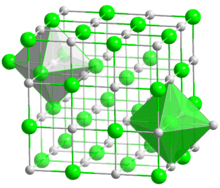Niobium nitride
 | |
| Names | |
|---|---|
| IUPAC name
Niobium nitride | |
| Identifiers | |
| 24621-21-4 | |
| ECHA InfoCard | 100.042.132 |
| PubChem | 90560 |
| Properties | |
| NbN | |
| Molar mass | 106.91 g/mol |
| Appearance | gray solid |
| Density | 8.470 g/cm3 |
| Melting point | 2,573 °C (4,663 °F; 2,846 K) |
| reacts to form ammonia | |
| Structure | |
| cubic, cF8 | |
| Fm3m, No. 225 | |
| Hazards | |
| Safety data sheet | External MSDS |
| Flash point | Non-flammable |
| Related compounds | |
| Other cations |
Vanadium nitride Tantalum nitride |
| Except where otherwise noted, data are given for materials in their standard state (at 25 °C [77 °F], 100 kPa). | |
| | |
| Infobox references | |
Niobium nitride is a compound of niobium and nitrogen (nitride) with the chemical formula NbN. At low temperatures (about 16 K) NbN, niobium nitride becomes a superconductor, and is used in detectors for infrared light.[1][2][3]
Uses
- Niobium nitride's main use is as a superconductor. Detectors based on it can detect a single photon in the 1-10 micrometer section of the infrared spectrum,[4] which is important for astronomy and telecommunications. It can detect changes up to 25 gigahertz.
- Niobium nitride is also used in absorbing anti-reflective coatings.
- In 2015, it was reported that Panasonic Corp. has developed a photocatalyst based on niobium nitride that can absorb 57% of sunlight to support the decomposition of water to produce hydrogen gas as fuel for electrochemical fuel cells.[5]
References
- ↑ Y. M. Shy, L. E. Toth and R. Somasundaram (1973). "Superconducting properties, electrical resistivities, and structure of NbN thin films". Journal of Applied Physics. 44: 5539. doi:10.1063/1.1662193.
- ↑ J. W. Kooi, J. J. A. Baselmans, M. Hajenius, J. R. Gao, T. M. Klapwijk, P. Dieleman, A. Baryshev and G. de Lange (2007). "IF impedance and mixer gain of NbN hot electron bolometers". Journal of Applied Physics. 101: 044511. doi:10.1063/1.2400086.
- ↑ S. P. Chockalingam, Madhavi Chand, John Jesudasan, Vikram Tripathi and Pratap Raychaudhuri (2009). "Superconducting properties and Hall effect in epitaxial NbN thin films". Physical Review B. 77: 214503. arXiv:0804.2945
 . doi:10.1103/PhysRevB.77.214503.
. doi:10.1103/PhysRevB.77.214503. - ↑ M Hajenius1, J J A Baselmans, J R Gao1, T M Klapwijk, P A J de Korte, B Voronov and G Gol'tsman (2004). "Low noise NbN superconducting hot electron bolometer mixers at 1.9 and 2.5 THz". Superconductor Science and Technology. 17: S224. doi:10.1088/0953-2048/17/5/026.
- ↑ Yamamura, Tetsushi (August 2, 2015). "Panasonic moves closer to home energy self-sufficiency with fuel cells". Asahi Shimbun. Retrieved 2015-08-02.
- "Niobium nitride". webelements.com. Retrieved 2006-08-08.
Further reading
This article is issued from Wikipedia - version of the 9/20/2016. The text is available under the Creative Commons Attribution/Share Alike but additional terms may apply for the media files.